Club Night Report
Wednesday 11th February 2015
Club Night Report for 11th February 2015 - observations by Vernon Hughes |
 |
 |
 |
 |
 |
 |
 |
 |
 |
 |
 |
 |
 |
Arthur Kingdon (Secretary) announced that this was to be a 'home-grown' evening with presentations by Ron Headon (Lace Bobbins) and Bob Sawyer (Bowl Turning).
Lace Bobbins - Ron Headon explained that the turning content of his presentation would be small and would come at the end - after an explanation of the history of lace (and therefore bobbin) making and a substantial display of slides and short videos on the subject.
Ron stated that weaving might date back as far as 2500 BC - a woven hairnet found at Thebes (the Egyptian one) having been placed at that point in human history. He then leapt forward to the 12th and 13th centuries when some lace garments were made for churchmen high in the ecclesiastical hierarchy. However, it seems that the 1500s marked the main surge in the lacemaking craft in Europe - note the use of lace in Queen Elizabeth's dress collars and in garments worn by Sir Francis Drake. The craft came up and across Europe from Ragusa (Sicily), Genoa and Venice and may have arrived in those Italian ports from China. Catherine of Aragon may even have had a hand in introducing it to Britain from Spain. Bringing us up to modern times Ron showed two lace cushions complete with dozens of bobbins and pins (plus a stand) that he had borrowed from a friend (Caroline) which indicate the potential complexity of the work.
Using slides Ron then took us through the wide variety of bobbin designs that have evolved in various lacemaking centres in the UK and abroad including some turned in bone instead of wood. The anatomy of a bobbin includes the head, a neck, a collar the shank and an optional spangle. Design details included tiny inserts in the bodies of some bobbins, loose captive rings (jingles) and the use of a small hole drilled through the bottom detail of the bobbin for the insertion of a wire that is then shaped into a circle on which spangles (typically coloured beads) of the laceworkers' choice have been threaded. This assists identification of individual bobbins, which are almost always used in pairs - plus the weight of the bobbin tensions the thread. A huge variety of commercially made bobbins are available - to include painted, carved and commemorative ranges. There are a number of special tools used to assist the lace maker.
The slides were followed by some videos of master bobbin turner Chris Parsons whose workshop is about twelve miles from Bath. He makes perfect bobbins (over 150,000 spread over thirty years) to a pleasing design with a certainty of touch and at a speed that provide a model for us all to aspire to (or perhaps more accurately to dream about). Chris set the toolrest unusually low and applied finger pressure support behind each bobbin throughout. See bottom of this page for website and video links.
Ron also demonstrated these important techniques when making one complete bobbin at the end of his presentation. Ron also dealt with timber holding using purpose-made bobbin drives, tool selection, marking-out patterns/ templates and use, and how to turn a 'mother and babe' style of bobbin making the babe separately and fitting it into a pre-formed slot using finger pressure. This had been a thoroughly interesting and well-researched talk-cum-demo, all delivered with down-to-earth but entirely successful aplomb. Thanks Ron!
 |
 |
 |
 |
 |
 |
 |
 |
 |
 |
Bowl Turning - Bob Sawyer set out to demonstrate the worth of a bowlsaver tool. He uses a 'Woodcut' but there are other makes. In this case he had obtained three bowl blanks from one large one but it is possible to obtain even more. He had already turned the large and medium blanks into fine bowls leaving the smallest as his demonstration sample for the evening.
The magnificent timber had come from a large windblown Honey Locust (Gleditsia Tricanthos) tree at a local large estate (Bowood House) whence he managed to obtain one pick-up truckload. He had to report ruefully though that the whole of the rest of this uncommon specimen tree had been reduced to wood-chippings by zealous woodland managers by the time he went back for more! (Author's Note: Gleditsia Tricanthos is a large, elegant, deciduous tree of North American origin).
Bob mounted the blank using a chuck recess to shape the outside, and a spigot when turning the inside, and completed the bowl by conventional methods very quickly. He did not waste time applying a finish though because the inside of the bowl had a mechanical flaw (wood screw hole!) that could not be overcome or worked out . He said the 3/8" bowl gouge that he used almost exclusively was his favourite tool and that he possessed six of them all ground to different bevel angles and lengths. He advised that when taking out the inside he works from rim to centre or vice versa going with the grain to determine which direction is the more appropriate. He said that when a hole has been drilled to an appropriate depth at the inside centre it speeds up the work but it is not essential. Do not be concerned about a dimple at the bottom centre of a bowl when it is otherwise complete. Just work at it until it has been removed, recognizing that confidence will grow with practice. He advised that when working on bowl shaping the feet should remain static. Moving the feet causes the cut to go off line. His final tip was that he turns most of his bowls in 'wettish' timber and check weighs them until he gets three readings at the same weight, whereupon they are remounted for finishing. An accompanying photograph shows the three bowls side by side and gives an indication of achievable proportions (colouring is richer in the photograph than in reality but the grain is exposed to great effect).
Almost before we knew it Bob had completed his project leaving us to realize that his confidence and sureness of approach had completed a job very readily that many another might take a good deal longer to achieve. Thanks Bob!
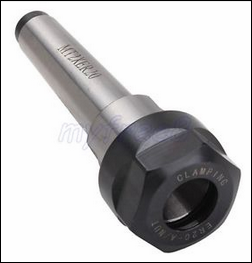 |
 |
Ian Full showed a power sanding tool - attaches to an electric drill - that incorporates the use of a vacuum cleaner for dust extraction. See here for details: www.pad-o-vac.co.uk
Links to Lace Bobbin information:
Chris Parsons Main Website: www.lace-bobbins.co.uk
And his online shop: www.thebobbinshop.com
Ron showed a couple of YouTube videos (created by Chris Parsons) to show the process of making a lace bobbin - apparently the spindle speed is around 6,000 rpm!
Turning a Lace Bobbin: www.youtube.com/watch?v=xxCc_oYQxa0
How to Turn a Mother and Babe Lace Bobbin: www.youtube.com/watch?v=01lEjMgojPE
Turning Captive Rings (Jingles) on a Lace Bobbin: www.youtube.com/watch?v=I3HM7CaC60g
<Top of Page>
The Show and Tell - theme for the evening was: Something Rustic - this was well supported and displayed some interesting pieces.
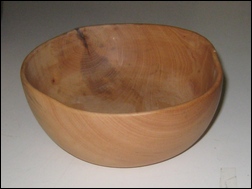 |
 |
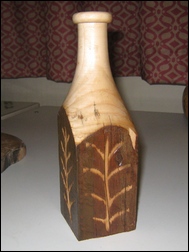 |
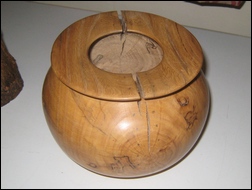 |
| Third place was awarded to a collections of Mushrooms on a Holly base by Phil Lawrence |
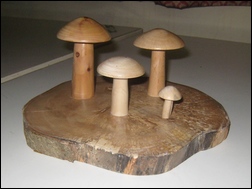 |
| There was a tie for first place between Richard Branscombe with an interesting Vase made from a 15 year old Wysteria root | 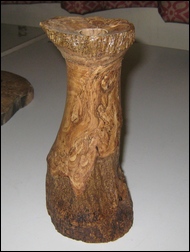 |
| And Dave Newman who took the Show and Tell shield home with a Rustic Box made in Cherry 'rescued' from a neighbours garden. |  |
